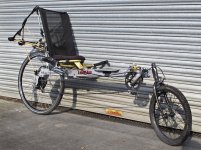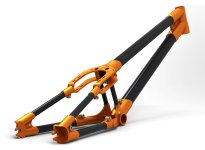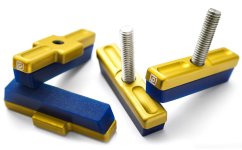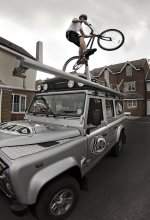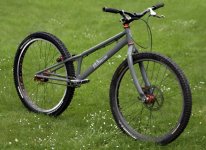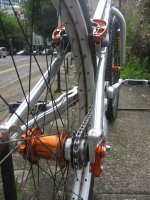MalvernMike
1 mW
- Joined
- Oct 24, 2012
- Messages
- 11
Howdy all. I'm glad to be a part of the forum and around like-minded folk who love experimenting, innovating and developing. There's so much about electric bikes that make them such a perfect platform to create with.
I've been a trials mountain-bike rider for about 11 years and for the last 4 years have been performing with the MAD mountain bike display team. In that time I've experimented a lot, working on custom frames, funky rims, brake pads and fluid, all sorts. (See some images at the bottom) As well as the trials riding, I now commute and tour on an old Linear Limo, which I absolutely love riding.
I'm now working on a completely custom project, and it'll be my first foray into electric bikes, other than a little bit of research whilst studying product design @ Loughborough.
Whilst the Bosch and panasonic units sound like they perform really well (the Bosch in particular), they're not going to offer me the level of design congruence I want to achieve in this project. Having looked at fwd, rwd, mid-drive, chain-drive and crank drive, it seems that combining the motor axle to the bottom bracket axle will be the cleanest (not necessarily easiest) way of adding power. As so much of this project needs to be completely designed in-house, the results will be worth the extra effort to include some interesting engineering into the equation. My task is to find a balance between creating everything from scratch vs using an off the shelf system like the Bosch. I hope with some help from you guys, we'll find a really great solution.
I'm looking at taking a compact hub motor (a 500w, 48v Cute motor look the best option to me at the moment), stripping it, mounting the hub shell as an integral part of the frame, creating a new axle for it, and mounting the cranks on the axle. The fact I will be using the FSA Metropolis Patterson crankset will add further complexity to the matter, but I'll save that discussion for a minute!
Depending who is riding, lets say the cadence will vary between 30 and 90rpm depending on who is riding. From what I've seen, most geared hub motors seem to have a torque multiplier of around 3-5, giving a working RPM range of 90/150-270/450 rpm range for the motor.
If I take a motor suited for a 28" wheel: At 15mph the wheel will be spinning at around 180rpm, so the motor would be working at 540-900rpm (3-5x torque multiplier). Is this a typical RPM figure for a hub motor working at an efficient level? This is where I'd appreciate a bit of general education from you guys - in finding something that will work efficiently at driving the axle at 30-90rpm.
The other thing to be considered is torque sensing. This project will not include a throttle, and maintaining instantaneous and relative motor power delivery with pedal power is a real priority. As this is such a custom project, there is a lot of room to include the most suited ideas.
Thanks, and I do hope this resource will be most valuable.
Mike.
I've been a trials mountain-bike rider for about 11 years and for the last 4 years have been performing with the MAD mountain bike display team. In that time I've experimented a lot, working on custom frames, funky rims, brake pads and fluid, all sorts. (See some images at the bottom) As well as the trials riding, I now commute and tour on an old Linear Limo, which I absolutely love riding.
I'm now working on a completely custom project, and it'll be my first foray into electric bikes, other than a little bit of research whilst studying product design @ Loughborough.
Whilst the Bosch and panasonic units sound like they perform really well (the Bosch in particular), they're not going to offer me the level of design congruence I want to achieve in this project. Having looked at fwd, rwd, mid-drive, chain-drive and crank drive, it seems that combining the motor axle to the bottom bracket axle will be the cleanest (not necessarily easiest) way of adding power. As so much of this project needs to be completely designed in-house, the results will be worth the extra effort to include some interesting engineering into the equation. My task is to find a balance between creating everything from scratch vs using an off the shelf system like the Bosch. I hope with some help from you guys, we'll find a really great solution.
I'm looking at taking a compact hub motor (a 500w, 48v Cute motor look the best option to me at the moment), stripping it, mounting the hub shell as an integral part of the frame, creating a new axle for it, and mounting the cranks on the axle. The fact I will be using the FSA Metropolis Patterson crankset will add further complexity to the matter, but I'll save that discussion for a minute!
Depending who is riding, lets say the cadence will vary between 30 and 90rpm depending on who is riding. From what I've seen, most geared hub motors seem to have a torque multiplier of around 3-5, giving a working RPM range of 90/150-270/450 rpm range for the motor.
If I take a motor suited for a 28" wheel: At 15mph the wheel will be spinning at around 180rpm, so the motor would be working at 540-900rpm (3-5x torque multiplier). Is this a typical RPM figure for a hub motor working at an efficient level? This is where I'd appreciate a bit of general education from you guys - in finding something that will work efficiently at driving the axle at 30-90rpm.
The other thing to be considered is torque sensing. This project will not include a throttle, and maintaining instantaneous and relative motor power delivery with pedal power is a real priority. As this is such a custom project, there is a lot of room to include the most suited ideas.
Thanks, and I do hope this resource will be most valuable.
Mike.


